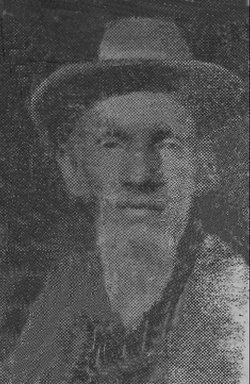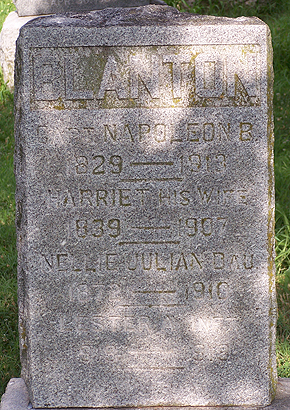But in 1854 Blanton, who had been born in Polk Count (sp), MO, in 1829, settled down at Lawrence, Kan., where he built a toll bridge across the Wakarusa River, four miles south of the town.
That was the year of the Kansas-Nebraska Act and a history-making time in the state. The personal story of the man who became Wichita's first motor vehicle fatality was wrapped up in the history of Kansas.
During the border wars, he served under Capt. John Brown in a number of famous territorial battles. He fought with Captain Walker during border troubles and with Col. James Lane at Titus' place near Lecompton. Kan. It is easy to conclude that the young bridge-building engineer was for abolition of slavery.
The toll bridge often netted $40 a day, which was a enviable income in the middle 1850s, and the Blantons built the first two-story log house in Lawrence.
Blanton and his family moved south. The railroad tracks were crossing into southeastern Kansas. He was surveyor. When a town was to be named, a coin was tossed to see which name of the railroad builders would appear on the new depot and the maps. The coin decided it was to be Coffeyville, not Blantonville. Again, when a town was started farther to the northeast, his keen perception dictated use of the name of a leader of a nearby community in order to sway sentiment, and trade, toward Humboldt. In 1955, Mrs. Lester A. Heckard of Hillcrest Apartments was a guest of honor at the 100th anniversary of Humboldt, the town her father had been instrumental in starting.
Mrs. Heckard was the youngest of 11 children and her memories are vivid about the years when Captain Blanton was helping to develop south-central Kansas. But in the meantime the family lived in an 11-room home at Coffeyville and the father went to the Territorial Legislature from Allen County.
In 1862 he raised a command for the Union Army which became known as the Fourth Kansas Infantry. His regiment made a gallant record during the war. He was on duty at Washington, D.C., and at Georgetown for a time and under General Sheridan at New Orleans. Mrs. Blanton made her home in Washington during the war years and was in Ford's Theater the night Abraham Lincoln was shot.
After the war he represented his district again in the Legislature, always on the Republican ticket.
From Allen County the Blantons went to Abbyville, Kan., where he was president of a land company that was developing that city. In 1878 he moved to Barber County.
There it was that Mrs. Heckard recalls the family home, so fine in those days, built of frame when most houses were soddies. A tornado had taken the roof off the Blanton soddie. Her father had hauled lumber 90 miles from Wichita to the farm near Hazelton.
She recalls her father as being a man who accomplished big things. They had a 40-acre orchard and a steel windmill supplying water to the back porch. That was a modern home, indeed. The house had eight rooms, was two stories high and cost $2,000.
There the Blantons lived the excitement of pioneer days with proverbial hospitality and the graciousness typical of a good provider.
After Mr. and Mrs. Heckard moved to Wichita in 1903 and following Mrs. Blanton's death, Captain Blanton came to reside with his daughter here. His love for growing plants continued to the end of his life and played a part in the accident which caused his death. On that April 29, 1913, when Wichitans were shocked by the first motor vehicle death, Captain Blanton, past 83 years of age, had gone to the vacant lot a few blocks north of the downtown area where he like to have a garden. On the way home he stopped at Dunn's Grocery, Mrs. Heckard related, to buy some of the fresh vegetables he enjoyed raising later in the season. These he was bringing home to her. He stepped onto the street and was hit by a vehicle which was said to be on the wrong side. He never regained consciousness.
Biographical information furnished by Jim Blanton FAG Member #47452515
But in 1854 Blanton, who had been born in Polk Count (sp), MO, in 1829, settled down at Lawrence, Kan., where he built a toll bridge across the Wakarusa River, four miles south of the town.
That was the year of the Kansas-Nebraska Act and a history-making time in the state. The personal story of the man who became Wichita's first motor vehicle fatality was wrapped up in the history of Kansas.
During the border wars, he served under Capt. John Brown in a number of famous territorial battles. He fought with Captain Walker during border troubles and with Col. James Lane at Titus' place near Lecompton. Kan. It is easy to conclude that the young bridge-building engineer was for abolition of slavery.
The toll bridge often netted $40 a day, which was a enviable income in the middle 1850s, and the Blantons built the first two-story log house in Lawrence.
Blanton and his family moved south. The railroad tracks were crossing into southeastern Kansas. He was surveyor. When a town was to be named, a coin was tossed to see which name of the railroad builders would appear on the new depot and the maps. The coin decided it was to be Coffeyville, not Blantonville. Again, when a town was started farther to the northeast, his keen perception dictated use of the name of a leader of a nearby community in order to sway sentiment, and trade, toward Humboldt. In 1955, Mrs. Lester A. Heckard of Hillcrest Apartments was a guest of honor at the 100th anniversary of Humboldt, the town her father had been instrumental in starting.
Mrs. Heckard was the youngest of 11 children and her memories are vivid about the years when Captain Blanton was helping to develop south-central Kansas. But in the meantime the family lived in an 11-room home at Coffeyville and the father went to the Territorial Legislature from Allen County.
In 1862 he raised a command for the Union Army which became known as the Fourth Kansas Infantry. His regiment made a gallant record during the war. He was on duty at Washington, D.C., and at Georgetown for a time and under General Sheridan at New Orleans. Mrs. Blanton made her home in Washington during the war years and was in Ford's Theater the night Abraham Lincoln was shot.
After the war he represented his district again in the Legislature, always on the Republican ticket.
From Allen County the Blantons went to Abbyville, Kan., where he was president of a land company that was developing that city. In 1878 he moved to Barber County.
There it was that Mrs. Heckard recalls the family home, so fine in those days, built of frame when most houses were soddies. A tornado had taken the roof off the Blanton soddie. Her father had hauled lumber 90 miles from Wichita to the farm near Hazelton.
She recalls her father as being a man who accomplished big things. They had a 40-acre orchard and a steel windmill supplying water to the back porch. That was a modern home, indeed. The house had eight rooms, was two stories high and cost $2,000.
There the Blantons lived the excitement of pioneer days with proverbial hospitality and the graciousness typical of a good provider.
After Mr. and Mrs. Heckard moved to Wichita in 1903 and following Mrs. Blanton's death, Captain Blanton came to reside with his daughter here. His love for growing plants continued to the end of his life and played a part in the accident which caused his death. On that April 29, 1913, when Wichitans were shocked by the first motor vehicle death, Captain Blanton, past 83 years of age, had gone to the vacant lot a few blocks north of the downtown area where he like to have a garden. On the way home he stopped at Dunn's Grocery, Mrs. Heckard related, to buy some of the fresh vegetables he enjoyed raising later in the season. These he was bringing home to her. He stepped onto the street and was hit by a vehicle which was said to be on the wrong side. He never regained consciousness.
Biographical information furnished by Jim Blanton FAG Member #47452515
Inscription
Capt Co H 10 KS In
Family Members
-
![]()
Adeline Matilda "Addie" Blanton Flynn
1859–1929
-
![]()
Emma E. Blanton Lindley
1863–1889
-
![]()
Fannie Blanton Streeter
1864–1954
-
Sally Blanton Savage
1870–1956
-
![]()
Nellie E. Blanton Julian
1872–1911
-
![]()
John F. Blanton
1875–1952
-
![]()
Frank Blanton
1877–1956
-
![]()
Bessie Blanton Heckard
1880–1959
-
![]()
Napoleon Bonaparte Blanton Jr
1884 – unknown
-
![]()
Charles Blanton
Sponsored by Ancestry
Advertisement
Explore more
Sponsored by Ancestry
Advertisement




















